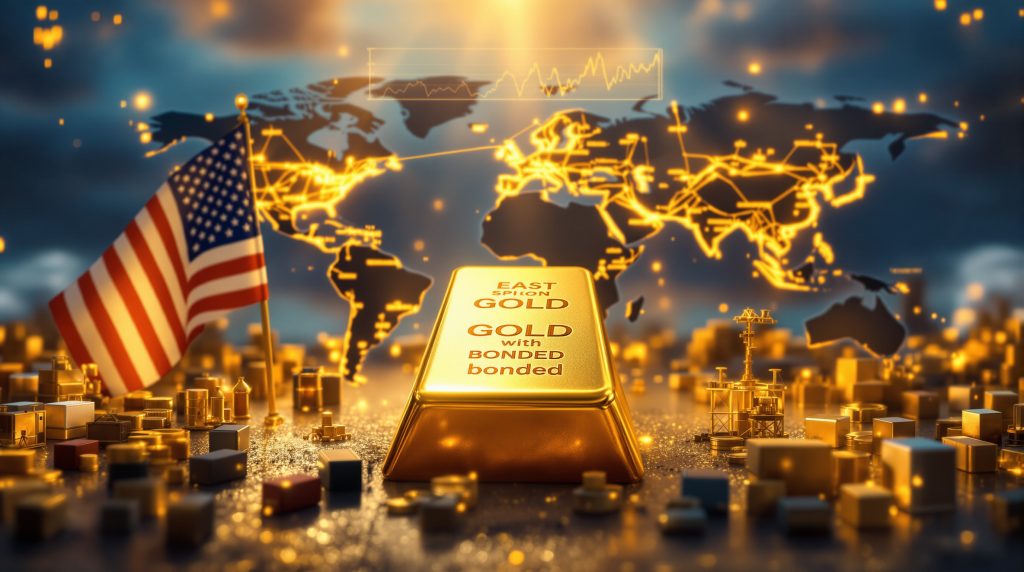Understanding the Impact of US Gold Tariffs on Global Markets
Recent shifts in US gold tariffs are creating profound ripple effects throughout the global precious metals landscape. These changes are not merely administrative adjustments but strategic moves reshaping traditional trading patterns and potentially altering the balance of power between Eastern and Western gold markets. For investors, mints, refineries, and sovereign nations, understanding these dynamics has become crucial for navigating what promises to be a transformative period.
Key Market Disruptions from Recent Tariff Uncertainty
The recent customs ruling regarding potential tariffs impact investment created immediate and significant market disruptions across the precious metals industry. Trading desks temporarily suspended gold sales, particularly for deliverable branded bars, while Exchange for Physical (EFP) premiums spiked dramatically, reaching $30-50 above normal levels.
Many dealers completely withdrew market offers during this uncertainty period, refusing to commit to sales without clear regulatory guidance. Metal shipments remained in limbo, held in bonded warehouses with uncertain status while awaiting clarification.
Despite subsequent clarifications for exchange-sized bars, retail-sized products (particularly 1oz bars) continue facing tariff application, highlighting the targeted nature of these regulatory changes. These events revealed significant vulnerabilities in the global gold supply chain that continue to influence market behavior and strategic planning.
Strategic Motivations Behind US Customs Rulings
The recent customs ruling that temporarily threatened Swiss gold with a 39% tariff appears to reflect a calculated shift in US trade policy rather than a simple administrative error. The ruling specifically targeted bars with "extra features" such as encrypted QR codes, suggesting a nuanced approach to classifying gold products.
Strategic Objectives Behind Tariff Considerations
The ruling appears aligned with broader economic objectives forming part of a comprehensive strategy:
- Encouraging domestic manufacturing of finished gold products while maintaining access to raw materials
- Strengthening Western Hemisphere economic integration between North and South America
- Addressing identified vulnerabilities in critical mineral supply chains
- Positioning the US to compete more effectively with China in precious metals manufacturing
- Supporting the administration's stated desire to increase US gold holdings and domestic production
The temporary market disruption provided valuable intelligence about supply chain vulnerabilities while signaling potential future policy directions. This appears to be part of a larger strategy to realign global precious metals flows toward US interests.
The Evolving East-West Gold Market Dynamic
The traditional gold market structure centered around London (LBMA) faces mounting challenges as global demand patterns shift eastward and jurisdictional concerns rise. This transition is exposing structural inefficiencies in the current system that many market participants can no longer ignore.
Structural Inefficiencies in the Current System
The current market structure reveals significant misalignments between historical trading practices and contemporary demand realities:
| Issue | Impact | Future Implication |
|---|---|---|
| Shipping 400oz London bars to Switzerland for re-refining into kilo bars | Added costs, energy consumption, and logistical strain | Growing pressure for market decentralization |
| Limited manufacturing near London storage hubs | Unnecessary transportation and processing | Potential shift toward manufacturing-proximate storage |
| LBMA described as an "opaque private club" | Reduced transparency and accessibility | Growing demand for alternative trading venues |
| Jurisdictional risks in European vaults | Concerns about asset seizures during geopolitical tensions | Acceleration of sovereign gold repatriation |
Emerging Centers of Gold Market Gravity
The market is witnessing the rise of new gold trading and storage hubs challenging London's traditional dominance:
- United States expanding domestic refining and storage capacity
- China continuing to develop and expand its gold market infrastructure
- Wyoming emerging as a potential new precious metals hub with foreign trade zone status
- Broader decentralization away from the traditional London-centered model
This redistribution reflects both changing demand patterns and growing concerns about jurisdictional risks in traditional storage locations. Most European storage facilities still hold seized Russian assets, creating uncertainty about the security of holdings in these jurisdictions during geopolitical tensions.
Institutional Investment Impact on Precious Metals Markets
Institutional capital is increasingly flowing into physical precious metals, creating new demand dynamics that extend well beyond traditional retail investors. Bloomberg recently reported that India's regulator may soon allow its $177 billion pension system to buy gold ETFs, with even a 1% allocation potentially representing approximately 17 tons of new gold demand.
Evolving Institutional Engagement Models
Several significant institutional investment trends are emerging:
- High-net-worth individuals and family offices making strategic allocations
- Fund-of-funds exploring precious metals exposure through various channels
- Banks acting as intermediaries for sovereign clients seeking physical metals
- Companies potentially adding gold to corporate balance sheets
- Pension systems globally reconsidering precious metals allocations
These institutional flows represent a fundamental shift from the primarily retail-driven demand of previous cycles. While retail demand has been relatively quiet over the past two years, sophisticated institutional buyers are actively entering the market, viewing current price levels as still attractive relative to historical ratios.
Critical Mineral Classifications Changing the Silver Market
Silver's potential classification as a critical mineral represents a significant shift in how governments view this precious metal, moving it from primarily an investment asset to a strategic resource with national security implications.
Strategic Implications of Silver's Changing Status
The reclassification carries several important consequences for market participants:
- Increased competition between industrial and investment demand
- Potential government stockpiling programs similar to historical strategic reserves
- Growing interest from sovereign wealth funds and pension systems
- Offtake agreements securing supply directly from mines and refineries
- Rising industrial demand from automotive, AI, and military applications
The US previously maintained silver stockpiles approximately 20 years ago before these reserves were depleted. Current discussions about returning silver to critical mineral status could signal a revival of strategic government purchasing programs.
Saudi Arabia has reportedly made strategic silver purchases, highlighting the growing sovereign interest in securing access to this metal. Furthermore, gold‐silver ratio insights suggest that these developments could mean the relatively small silver market could face significant pressure if multiple large players begin competing for limited supply.
Platinum's Role in the Future Energy Economy
Platinum has shown significant price strength after years of underperformance, driven by changing automotive trends and expanding industrial applications. This resurgence challenges assumptions about the metal's prospects in an electrifying transportation sector.
Factors Driving Platinum's Resurgence
Several key developments support platinum's improving outlook:
- Declining pure EV sales contrasted with rising hybrid vehicle production
- Hybrid vehicles requiring more platinum for catalytic converters due to frequent engine starts
- Strategic purchases by China and other nations building reserves
- Relative value compared to gold after years of underperformance
- Potential applications in hydrogen economy infrastructure
These factors are attracting both tactical allocations from high-net-worth individuals and strategic investments from funds and sovereign entities. Recent platinum market dynamics combined with its inflation-hedging properties creates a compelling case for inclusion in diversified precious metals portfolios.
Sovereign Nations Changing Their Approach to Gold
Government policies toward gold are evolving rapidly as nations reassess its strategic importance in an increasingly uncertain geopolitical environment. These shifts reflect a broader reevaluation of gold's role in national economic security.
Evolving Sovereign Gold Strategies
Recent developments highlight changing government perspectives:
- Vietnam ending its state monopoly on gold bullion production
- Central banks continuing gold purchases regardless of price levels
- Some central banks implementing automatic purchase programs on quarterly or monthly schedules
- Growing interest in gold as a settlement layer among BRICS nations
- Russian Central Bank investigating precious metals earlier in 2025
- Companies like Tesla amending bylaws to allow for gold bullion holdings
These changes reflect a broader reassessment of gold's role in national economic security and monetary systems. The ongoing gold market surge has shown that central banks have become "price agnostic" in their purchasing strategies, focusing on allocation rather than timing, which creates a consistent demand floor for the market.
Biggest Risks for Physical Gold Investors
While price volatility remains a concern for many investors, the more significant long-term risks may involve market access and control rather than temporary price fluctuations. These structural risks require different mitigation strategies than traditional market timing approaches.
Evolving Risk Landscape for Physical Metals
Investors face several emerging challenges:
- Potential restrictions on bullion market access as metals are classified as strategic resources
- Growing politicization of precious metals markets at national levels
- Possible limitations on private ownership or transaction sizes
- Increasing regulatory oversight and reporting requirements
- Supply chain disruptions due to gold bar tariff confusion
- Counterparty risks within traditional storage systems
These factors suggest that positioning before access becomes restricted may be more important than timing short-term price movements. As precious metals increasingly serve dual roles as both investment assets and strategic resources, the regulatory environment is likely to become more complex.
Best Practices for Physical Precious Metals Purchases
For both experienced investors and first-time buyers, a methodical approach to physical precious metals acquisition is essential. The current market environment requires careful consideration of both purchase and storage strategies.
Best Practices for Physical Metals Acquisition
Key recommendations include:
- Conducting thorough research on dealers and their business longevity
- Comparing prices across multiple vendors before committing
- Starting with smaller purchases to test transaction processes
- Viewing acquisition as a journey rather than a one-time event
- Considering regular allocation programs similar to central bank approaches
- Understanding the differences between physical ownership and paper products
- Verifying storage arrangements and audit procedures for larger holdings
This measured approach aligns with how sophisticated institutional investors are building their precious metals positions. By focusing on process rather than timing, investors can build significant positions while minimizing transaction risks.
The Transformative Decade Ahead
The precious metals market is experiencing structural changes that extend far beyond price movements. US gold tariffs represent just one aspect of a broader realignment in how governments, institutions, and individuals view gold, silver, and platinum.
The global precious metals landscape is shifting from a London-centered model toward a more decentralized structure with multiple centers of gravity. This transition reflects both changing demand patterns and growing concerns about jurisdictional risks in traditional storage locations.
As we leave the era of global harmony in trade, resource competition is intensifying. Nations are securing their industrial futures through strategic mineral purchases and partnership agreements, creating new pressures on precious metals markets. Recent all‐time high gold prices demonstrate the impact of these shifting dynamics.
The coming years are likely to be defined by both higher prices and tighter access as these metals increasingly serve dual roles as both investment assets and strategic resources. According to Reuters reports on gold tariffs, market participants who understand these evolving dynamics will be better positioned to navigate what promises to be a transformative decade for precious metals.
The decoupling of global trade and increasing bifurcation of markets suggest that strategic positioning may be more important than tactical timing. As one market expert noted, when banks, governments, industrial players, and retail investors all clamor for the same asset class simultaneously, "that's when you see fireworks."
Ready to Stay Ahead of Major Mining Discoveries?
Discover ASX mineral opportunities before the market with Discovery Alert's proprietary Discovery IQ model, turning complex data into actionable insights for both short-term traders and long-term investors. Explore why historic discoveries lead to significant returns by visiting the dedicated discoveries page and begin your 30-day free trial today.




